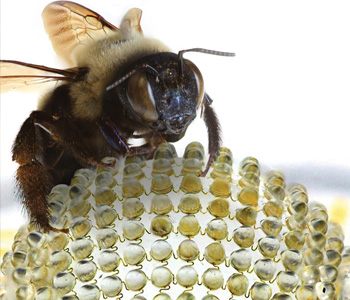 A compound apposition digital camera system that replicates the compound eyes of insects. [University of Illinois at Urbana-Champaign / University of Houston]
A compound apposition digital camera system that replicates the compound eyes of insects. [University of Illinois at Urbana-Champaign / University of Houston]
Nature has had billions of years of evolution to perfect its complex biological wonders, and scientists have been using natural systems as inspiration for centuries. The hooks on the surface of cockle burrs (burdock) were the inspiration for Velcro. The strength, luster and mobility of shark skin inspired micro-textured fabric. The spikey “nanopillar” structure on the wings of cicadas and dragonflies is so effective at rupturing bacteria, it inspired the development of antibacterial surfaces on numerous products.
The field of biomimetics, coined by American biophysicist Otto Schmitt in the 1950s, is the imitation of natural models, systems and elements to solve human problems. Similarly, researchers in bio-inspired photonics use natural design as their inspiration to take those solutions in new directions.
Recently, photonics researchers have begun to understand the mechanisms behind such biological mysteries as firefly lanterns, iridescent butterfly wings and the adaptive camouflage of octopus skin, and to use them as models for the next generation of photonics technology like light-emitting diodes (LEDs), sensors and materials.
|
Vision systems
The field of bio-inspired photonics is of particular interest to John Rogers, Swanlund Chair and professor of materials science at the University of Illinois at Urbana-Champaign (USA). Rogers is interested in understanding and imitating the “soft” materials found in nature to invent new types of conformal electronics, nanophotonic systems and microelectromechanical systems.
One type of soft material system that’s hard to imitate but highly efficient is the sophisticated eyesight of living creatures. For example, arthropods—invertebrates with an exoskeleton, segmented body and jointed appendages, like ants, beetles, arachnids and crustaceans—have hemispherical eyes that provide vision with a wide field of view, low aberration, high acuity to motion and an infinite depth of field (pictures of an object located at different distances produces images of the same size on the lens). The ability to achieve a 180-degree field of view with zero aberrations is only possible with hemispherical imaging systems. That, along with infinite depth of field, makes such systems ideal for drone surveillance or endoscopy.
To imitate arthropod vision systems, Rogers and an international multidisciplinary team fabricated a digital camera comprising an array 180 imaging elements, similar to the eyes of fire ants and bark beetles. Each small eye element, called an ommatidium, involves a single silicon photodiode topped by a single convex elastomeric microlens. The elements in the array are connected with serpentine electrical readouts to form a mesh that can be embedded on a flexible base membrane and stretched into a hemispherical shape a centimeter in diameter.
When tested, the “apposition compound eye” camera system successfully retrieved high-contrast images of a soccer ball and the Chinese character for “eye.” The images, reconstructed using models of the optics, boasted a 160-degree field of view and were recognizable but blurry, as can be expected from a system with only 180 elements, and the resolution is comparable to the vision of many arthropods and mammals.
The team reports that an improved effective resolution is possible via improvements to the optics, and rapid scanning of the eye or object, as in biology, as well as the addition of many more ommatidia to each camera system. Also, different software algorithms could make the camera adaptable to different light levels.
“Such advanced vision systems that are better than those found in biology are readily achievable through straightforward extensions in this kind of technology,” said Rogers.
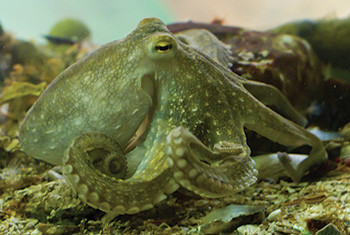
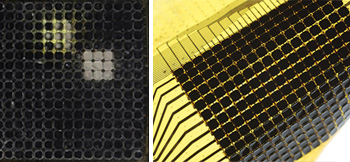 Researchers have developed an optoelectronic adaptive camouflage system that mimics the pigment-containing chromatophores in the skin of cephalopods. (Bottom, left) Upon illumination with a silicon diode, the cells in the bio-inspired system heat up to quickly change the color of the dye, independent of viewing angle. (Bottom, right) A 16 x 16 sheet of interconnected unit cells is flexible up to a bend radius of 2 mm. [(Top) Thinkstock; (Bottom) Univ. of Illinois at Urbana-Champaign/Univ. of Houston]
Researchers have developed an optoelectronic adaptive camouflage system that mimics the pigment-containing chromatophores in the skin of cephalopods. (Bottom, left) Upon illumination with a silicon diode, the cells in the bio-inspired system heat up to quickly change the color of the dye, independent of viewing angle. (Bottom, right) A 16 x 16 sheet of interconnected unit cells is flexible up to a bend radius of 2 mm. [(Top) Thinkstock; (Bottom) Univ. of Illinois at Urbana-Champaign/Univ. of Houston]
From octopus to optoelectronics
The skin of cephalopods, marine animals with tentacles like octopus and squid, can quickly change color to adapt to its environment, thanks to three layers of physiological systems. One layer involves special cells called chromataphores that hold an inky pigment under the skin’s surface. In response to light, the cells retract or expand rapidly in a matter of milliseconds. The other two layers contain reflective iridophore cells and light-diffusing white leucophore cells. The emerging understanding of how these layers work together to allow cephalopods to quickly camouflage their bodies has motivated scientific efforts to invent similar structures that would enable artificial optoelectronic camouflage.
Inspired by cephalopod skin, Rogers and marine biologist Roger Hanlon at the Marine Biological Laboratory in Woods Hole (USA) formed an international multidisciplinary team to create a complex scheme for adaptive optoelectronic systems made of flexible sheets that autonomously sense and change color in response to their surroundings. These sheets have high-performance, multiplexed arrays of photodetectors and actuators in multiple layers, configured on laminated, flexible substrates. The system is overlaid with pixilated thermosensitive leucodye in a light-sensitive transparent polymer, creating color-changing elements similar to chromatophores.
A white reflective layer made of silver underneath mimics leucophores, while a light sensor provides feedback to the diodes. The light reaches the photoreceptors above the dye through corner notches in each pixel.
At low temperatures, the dye is black, but when heated with a diode to 47 °C, the dye appears clear—a response that occurs within 1 to 2 seconds. Thus far, the device is limited to creating black and white patterns, but Rogers sees potential for improvement to the architecture that could lead to switching with electric fields or current.
The layered sheets are less than 200 µm thick, which leave them flexible enough to be conformally wrapped onto solid objects to change their appearance. Furthermore, the new adaptive camouflage technology has potential to be produced in scalable quantities. The optoelectronic architecture could help realize adaptive camouflage in consumer, industrial and military applications.
“It is beginning to be possible to imagine manmade systems with functions that rival the complex systems of cephalopods for camouflage,” says Rogers.
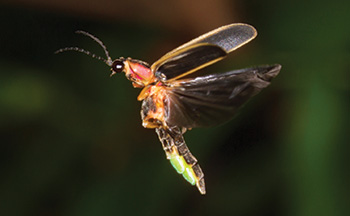
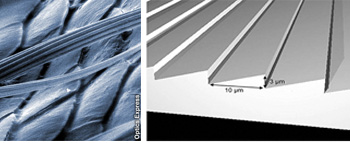 The Photorus firefly has jagged cuticle scales on the surface of its bioluminescent organ (bottom, left), which inspired an internal coating (bottom, right) that improves light-extraction for blue GaN LEDs. [(Top) iStock; (Bottom) A. Bay/University of Namur]
The Photorus firefly has jagged cuticle scales on the surface of its bioluminescent organ (bottom, left), which inspired an internal coating (bottom, right) that improves light-extraction for blue GaN LEDs. [(Top) iStock; (Bottom) A. Bay/University of Namur]
Lightning bug LEDs
Colorful and bright insects have long lent inspiration to science research, including that of postdoctoral researcher Annick Bay at the Scripps Institution of Oceanography at the University of California, San Diego (USA). Like many biomimetics researchers before her, Bay is inspired by the way insects have evolved to efficiently emit and reflect light. In recent years, she and her colleague, Alexandre Mayer, research associate in physics at the University of Namur (Belgium), have studied ways to optimize optical devices based on the morphology of insects.
In 2013, Bay and colleagues in Belgium studied the iridescent blue-violet bristles on the legs of the Pamphobeteus antinous tarantula and found that they act as cylindrical Bragg mirrors to cause its color. More recently, Bay identified that the cuticle of the bioluminescent organ of Photuris fireflies has a periodic jagged structure, like thick tiles of a factory roof, which significantly enhances light extraction. Mayer and Bay recognized that they could apply a genetic algorithm inspired by natural selection to the parameters of an optical device such as an LED, to identify the optimal internal structure for improving light-extraction efficiencies.
“Nature selects, generation after generation, solutions that are better adapted to a particular environment,” says Mayer. “We can apply genetic algorithms to mimic this process and determine optimal solutions to complex physics problems.”
Mayer set out to enhance the light-extraction efficiency, h, of a blue gallium-nitride (GaN) LED, which is limited by total internal reflections of the smooth interior surface. Using the genetic algorithm they developed, they found a 2-D design that would help significantly. The algorithm determined that a structure inspired from the jagged scales of fireflies would lead to peak efficiencies when transposed to the LED. As such, application of the optimal structural parameters found by the genetic algorithm to a GaN LED could bring its light extraction efficiency from 3.7 percent (with a planar surface) to 11.1 percent.
Bay and Mayer plan to consider 3-D structures for future surface texturization studies, and use of a material with the same dielectric constant as the GaN LED.
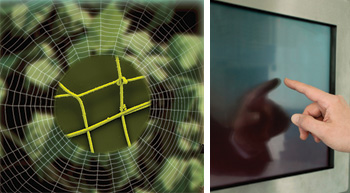 The uniformity of a spider’s web and the strength of its silk make it a natural model for touch screen displays. [(Left) J. Gao, China Normal University; (Right) iStock]
The uniformity of a spider’s web and the strength of its silk make it a natural model for touch screen displays. [(Left) J. Gao, China Normal University; (Right) iStock]
Spider webs and touch screens
As soon as a trapped insect moves on a spider’s web, the spider knows exactly where the prey is located. So why not use a spider web as the basis for the next generation of touch-based optoelectronics applications?
Influenced by the uniformity of a spider web structure and the strength of its silk, researchers in China and the United States created a transparent conductive film for use in touch screen displays. The bio-inspired design efficiently draws light through an optoelectronic device, according to Jinwei Gao, associate professor at the Institute for Advanced Materials and the Academy of Advanced Optoelectronics at South China Normal University. The team also used the metalized web in a thin-film amorphous silicon (a-Si) solar cell to achieve “highly efficient current transport, desirable mechanical properties and minimal light shading.”
The method is low cost and lends itself to a simple fabrication process, the team reported. The web makes the solar cell very flexible, enabling it to be stretched up to 25 percent without a loss in performance.
“Natural forms like spider webs or the venation systems of leaves offer an ingenious network model for new micro- and nanoscaffolds,” said Gao.
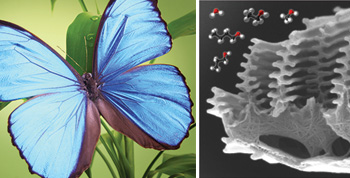 (Left) The wings of the Morpho butterfly “detect” mid-wave infrared radiation wavelengths of light as changes in iridescence. (Right) The iridescence is caused by interference on the horizontal lamella and diffraction on the vertical ridges on each scale. [(Left) iStock; (Right) R. Potyrailo / GE Global Research]
(Left) The wings of the Morpho butterfly “detect” mid-wave infrared radiation wavelengths of light as changes in iridescence. (Right) The iridescence is caused by interference on the horizontal lamella and diffraction on the vertical ridges on each scale. [(Left) iStock; (Right) R. Potyrailo / GE Global Research]
On the wings of butterflies
Morpho butterflies are a beautiful example of photonics engineering in nature. Their brilliant iridescent wings have scales that reflect light at selected wavelengths, making them shimmer in blue, green and purple. The properties of the Morpho’s wings also change with respect to temperature, causing the colors to shift. The conspicuous appearance of the butterfly is due to nanostructures on the top of their wing scales that look like fern fronds or trees. A cross-sectional view of the scales shows tall vertical stems (ridges) with horizontal branches (lamella), in which light diffracts and interferes to cause the vivid colorful iridescence.
These scales are made of a common biopolymer called chitin. Chitin has a lower heat capacity than many materials used in thermal sensors, so it cools quickly. In the past few years, the scales have inspired a plethora of new designs, including displays, unusual fabrics and cosmetics free of chemical pigments.
In 2012, Radislav Potyrailo, principal scientist at GE Global Research (USA), and colleagues had the idea to swap 40 years of bolometer research for the five-million-year-old design of the tropical Morpho. The group recognized that the thermal response architecture of the Morpho’s scales would make an attractive platform for optical cavity resonators for wavelength “conversion” of mid-wave infrared radiation (MWIR) of 3 to 8 µm into visible iridescence. The team placed single-walled carbon nanotubes on the natural nanostructured surface of the wings to improve thermal coupling, and achieved MWIR detection with a temperature sensitivity of 18 to 62 mK and a 35 to 40 Hz response speed without a heat sink—a significant improvement over existing bolometers.
The development made ripples for its potential use in low-cost thermal night vision without bulky heat sinks, and high-speed imaging of infrared photons. GE predicts that within the next five years, commercial thermal sensing products could reach the market in applications such as before-and-after medical diagnosis of patient inflammation, public safety and homeland security surveillance, handheld thermal imagers for firefighters and nondestructive inspection.
“These exciting advances could change thermal imaging with narrower temperature resolution, more sensitivity, better spatial resolution and making the technology easier to manufacture,” said Potyrailo. “Imagine that the beauty of the Morpho would inspire the design of a lower cost, more advanced bolometer system!”
The Morpho also has an unusually selective optical response to gases and chemicals. In 2013, Potyrailo’s group at GE, in collaboration with the University at Albany (USA), the U.S. Air Force Research Laboratory and the University of Exeter (England), further explored the structure of the wings to reveal a vertical surface polarity gradient in their tree-like nanostructures, which may explain why. They found that the change in surface polarity of the ridge structures in the cuticle is formed naturally and varies from most polar at the top to less polar at the bottom. This type of biological pattern could have numerous applications as ultra-sensitive, chemically graded sensing units in security tags, self-cleaning surfaces, gas separators, protective clothing and sensors.
In 2014, Potyrailo and his colleagues identified the optical change in reflectance of the Morpho butterfly’s wings when exposed to different vapors, a step toward characterizing the structure for potential use in biomimetic chemical sensors for over a thousand types of substances. The group is currently finishing up its testing of structures fabricated using different types of nanofabrication technology.
“These future bio-inspired sensors could provide an enhanced response to heat and chemicals,” said Potyrailo. “They could be sensors in a myriad of applications, including wearable, handheld, stationary or mobile unobtrusive devices in the Internet of Things”—the interconnection of uniquely identifiable embedded computing devices within the existing Internet infrastructure—“or could be woven into sports apparel or embedded in industrial protective clothing.”
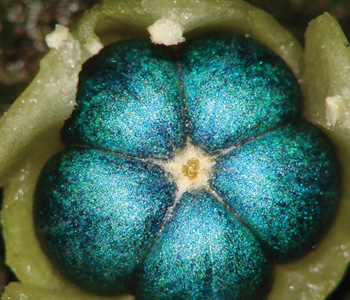
 In magnification, the fabric inspired by the iridescent bluish-green bastard hogberry seed hull changes color when stretched. [(Top) Herbario / Universidad Católica de Oriente; (Bottom) Mathias Kolle]
In magnification, the fabric inspired by the iridescent bluish-green bastard hogberry seed hull changes color when stretched. [(Top) Herbario / Universidad Católica de Oriente; (Bottom) Mathias Kolle]
Fruit and fiber
The seed hull of the Margaritaria nobilis fruit is another source of inspiration to science for its iridescent appearance. Also known as “bastard hogberry,” the fruit-bearing shrub grows in the rainforests of Central America, South America and the West Indies. The striking turquoise-blue hue drove physicist Pete Vukusic at the University of Exeter and his colleagues to study the berry’s skin. Under a microscope, they found the source of the color: elongated blue cells stacked in concentric layers inside the outer tissues. Each cell consists of highly periodic material rolled concentrically around the berry like the skin of an onion, which causes light to bounce around in complex patterns that produce the blue-green iridescence at 180 ± 30 nm in wavelength. They found that pulling gently at the rubbery fibers of the fruit changed the skin color slightly from red (thick) to blue (thin).
This bi-layered architecture inspired Vukusic and his team to experiment with designs for a soft, stretchy novelty fabric. Colleague Mathias Kolle, assistant professor in the department of mechanical engineering at the Massachusetts Institute of Technology (USA), suggested that athletic wear and gloves could be woven with the fiber to show an intriguing color change when the wearer flexes or bends. In 2013, the team created smart, color-dynamic fabric samples several inches long. To create a textile with high-enough volume for commercial ventures, they need to scale up their inexpensive room-temperature fiber-rolling technique.
The group also presented a design for novel multilayer optical fiber with a large tunable bandgap in the visible spectrum, from ultraviolet to visible. The center frequency and therefore color of the fiber can be designed by adjusting the thickness of the two individual layers in the fiber. The same ambient-temperature rolling technique lends itself to creation of chirped multilayer Bragg fibers, asymmetric structures, chirality and incorporation of gold or silver layers for novel metamaterials. In addition to novelty clothing, Vukusic and Kolle suggest possibly using the fiber in surgical sutures that provide color cues to tell surgeons when adequate tension is applied around the wound.
“Organisms that rely on an optical effect for their survival have optimized this effect to a sufficiently high extent to be relevant for us,” says Kolle. “They provide us with advanced starting points for the development of novel optical technology. Nature is one big treasure trove of successfully conducted materials science experiments.”
Valerie C. Coffey is a freelance science and technology writer and editor roving the United States in a 45-foot motor coach with a mobile hotspot.
References and Resources
-
A. Pris et al. Nat. Photon. 6, 195 (2012).
-
M. Kolle et al. Adv. Mater. 25, 2239 (2013).
-
S. Pogodin et al. Biophys. J. 104, 835 (2013).
-
R. Potyrailo et al. Proc. Natl. Acad. Sci. USA 110, 15567 (2013).
-
Y.M. Song et al. Nature 497, 95 (2013).
-
B. Han et al. Nat. Commun. 5, 5674 (2014).
-
T. Starkey et al. MRS Proc. 1621, 197 (2014).
